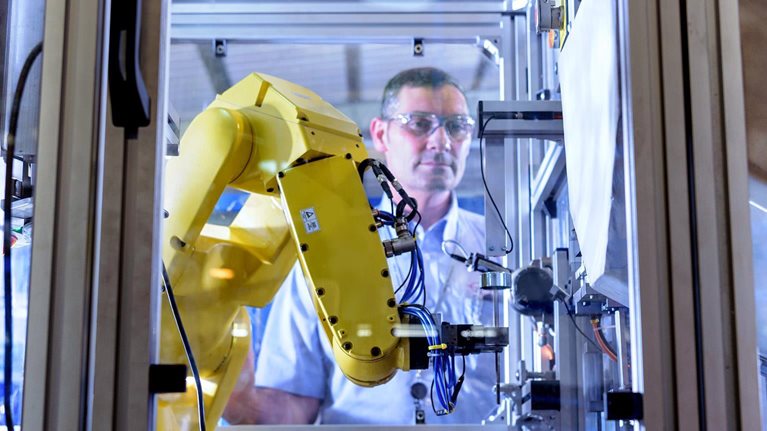The promise of devices that not only meet our household needs but anticipate them as well has been around for decades. To date, that promise remains largely unfulfilled. Advances such as the Nest thermostat by Alphabet (parent company to Google) and Amazon’s Alexa personal assistant are notable, but the home-technology market as a whole remains fragmented, and the potential for a truly smart home is still unrealized.
A tipping point may be at hand. Increased computing power, advanced big data analytics, and the emergence of artificial intelligence (AI) are starting to change the way we go about our busy lives. The vision we present in this article may seem “out there,” but it simply represents the confluence of those technological developments and realization of existing trends. Those trends, along with what’s just on the horizon, according to our research, suggest to us that within a decade, many of us will live in “smart homes” that will feature an intelligent and coordinated ecosystem of software and devices, or “homebots,” which will manage and perform household tasks and even establish emotional connections with us.
A smart home will be akin to a human central nervous system. A central platform, or “brain,” will be at the core. Individual homebots of different computing power will radiate out from this platform and perform a wide variety of tasks, including supervising other bots. Homebots can be as diverse as their roles: big, small, invisible (such as the software that runs systems or products), shared, and personal. Some homebots will be companions or assistants, others wealth planners and accountants. We will have homebots as coaches, window washers, and household managers, throughout our home.
We are already entering this new era. In two years, we expect to see more items in our living space become interconnected—the formative first stage of a new home ecosystem. In five years, numerous tools and devices in the home will be affected. And in ten years, smart homes will become commonplace and will regularly feature devices and systems with independent intelligence and apparent emotion.
That level of home improvement presents significant opportunities, threats, and changes for appliances and devices that have been part of our home life for generations. The new home will be built on a foundation of platforms and ecosystems, whose producers will need to establish new levels of trust with their customers. Competition will take place not just for the consumers who inhabit the smart home, but for the interactions between consumers and homebots that increasingly will shape buying behavior. It’s not too early for a wide range of players to start laying the groundwork for success in the home of the future.
The new homebot landscape
When we envisage smart homes to come, two core features are starkly apparent.
Platforms
Platforms will provide the foundation to integrate different devices while providing a consistent interface for the consumer. Frontrunners include Amazon, Apple, Google, and Samsung; start-ups at various points in the development cycle will be part of the mix, as well. The winners will deliver omnipresence through ubiquitous connectivity and go-anywhere hardware, as well as integration, with bots collaborating among each other and linking to third parties’ products and services. If the recent past is any indication, it’s likely that multiple platform standards will evolve. That will present complexities both for consumers and businesses but will foster new, niche opportunities, as well.
Would you like to learn more about our Digital McKinsey Practice?
Product and service ecosystems
Developers will create bots that plug into the new and various platforms. In short order, this combination of platforms and bots will mature into an ecosystem of products and services. Platform companies are likely to develop their own AI-driven bots (the descendants of Amazon’s Alexa and Apple’s Siri, for example). Many other creators will develop unique homebots that integrate into different platforms, much as the apps of today have been developed for Android and iOS, which support the impressive mobile-device ecosystems we see now.
Likely, too, a hierarchy will emerge: we can expect a “master bot” that acts as general manager, juggling many services; “service bots” that handle a set of functions related to a more complex task such as managing media; and “niche bots” that perform single tasks, such as window cleaning. For now, put aside grand visions of a single, Jetsons-style Rosie the Robot replacing a human maid in toto; think instead of multiple bots performing separable, specific tasks. Well-defined scope presents much less risk of error. “If you have a robot at home,” notes Gary Marcus, a futurist and professor of psychology at New York University, “you can’t have it run into your furniture too many times. You don’t want it to put your cat in the dishwasher even once.”
Trust will be a must-have
To better understand the homebot opportunity and potential obstacles to its realization, we conducted in-home and mobile diary studies in Japan and the United States with dozens of consumers who are already using AI products or services where they live. We found that satisfaction with individual smart devices runs high. Today, people are quite willing to invite homebots into their lives to address a broad array of specific use cases: from doing individual chores to completing a more complex set of tasks to managing even certain elements of child and elder care.
But we also found there’s a crucial variable that will determine the speed and extent to which consumers truly embrace smart homes managed by homebots. The overwhelmingly determinative factor for consumer acceptance that emerged from our research was trust. Trust is initially based on the bot’s ability to perform its task, as might be expected. That does not always go as planned. But once trust is established, people are willing to cede more responsibilities to devices and systems powered by AI. One key to creating that trust will be creating bots that are more than mere automatons. After all, humans are wired for emotions. Our research confirmed that consumers are satisfied when a bot gets a task done, but they are delighted when there is a more personal, emotional element to how the bot does it.
Competing through homebots
At the same time as competitors in the smart-home space are figuring out how to create trust, they also must learn how to compete in a new landscape where the winners are influencing the homebots themselves. As consumer–bot interactions become a new nexus of competition, a variety of players will need new skills in designing bots, marketing products and services to them, and building business models that exploit their position at the center of the home.
Designing bots
Increasingly, designers will tap into and even advance data science to develop solutions that go beyond addressing static insights. Likely, that will entail solutions that are at least in part AI-driven, in order to react instantly and evolve constantly for the needs of customers. By understanding customers through a variety of approaches including ethnographic research and AI-generated insights, designers can help guide businesses through the complicated tangle of interactions and diverse engagement models. We expect solutions will migrate from screen-dominated interfaces to more physical and even atmospheric interactions. Companies that have more compelling and intuitive engagement models between bots and consumers—and can achieve significant market penetration first—will hold the competitive advantage.
To become machines that are truly integral to peoples’ home lives and to establish genuine trust, bots will need to connect with and relate to humans. That’s hard, and it goes beyond AI to the realms of artificial emotion (AE). AE encompasses attributes such as tone, attitude, and gestures that communicate feelings and build an emotional connection. Consider Alexa. Several of our interview subjects told us that they think of Alexa as a friend. That doesn’t develop from merely providing the train schedule when asked. It comes because Alexa evokes a sense of support, through its sensitive omnipresence and nuanced voice interaction. Interacting with Alexa really is like talking to a friend.
Marketing products and services to bots
As consumers trust bots more and in turn cede to bots more control over their home management, people will become less involved in the active decision making that goes on in daily home life. For providers of home goods and services, this means that bots will increasingly become the customer— or at least an important intermediary between a selling business and a human purchaser.
Marketing for bots certainly gives new meaning to the term robocalls. But it also poses a serious challenge: How can businesses position their products and services to a bot so the human consumer will passively allow, or actively ensure, a purchase (exhibit)? We expect that the marketer’s mission will be comparable to the steps one takes to rank one’s product or service at the top of an Internet search result. Just as companies focus on search-engine optimization, they will need to develop metadata and tagging systems that are optimized for homebots.

Given the simplicity of automated purchases and refills for many household products, sellers will need to focus on getting into a homebot’s “consideration set” and optimize features to win the likely comparisons embedded in a purchase-decision algorithm. That calls for an approach that is much harder than “one and done.” Given the speed and reach of AI, providers will have to monitor bot purchasing behaviors continuously and be vigilant in tracking competitors’ moves going forward.

There’s no place like (a connected) home
The stakes are real; a shift in AI preference toward a competing product could reduce demand to zero. The once all-powerful intangible power of a brand may now be reduced to a tangible sum of its parts. As AI gathers inputs across consumer networks, unpleasant consumer experiences or negative feedback could have near immediate impact on bot purchasing preferences. As a result, analytics and marketing will need to be rapid, responsive, and agile. Consumers who can’t be bothered to search for the right purchase or are overwhelmed by the complexity of choice can have a homebot scan constantly based on variable individual preferences (such as cost, appearance, and durability).
Evolving business models
We expect that a wide range of homebot business models and use cases will emerge. Not only could homebots be purchased or rented for a specific task, people may share or rent them out to others. It’s conceivable that networked bots will work together across households, for example, to increase processing power, share expenses, or even partake in buyer co-ops to benefit from bulk pricing. Each of these models creates opportunities for new revenue streams.
The greatest source of value may come from the data. Bots will acquire and generate reams of information, and these data points will be critical for increasingly data-driven projects and services. Data will be sources of insight and even products in their own right. And understanding the implications, opportunities, and information about the smart home won’t be someone’s part-time job. It will require a dedicated team to parse the data, develop strategies, manage partnerships, and drive experiments that will become integral to creating value.
Laying the foundation
Businesses that seek to compete in the smart home can begin their housework early. A network of functioning bots is, in effect, an ecosystem of capabilities. Each bot will need to follow standard protocols to communicate with one another. But while a house may be bounded by four walls, a homebot ecosystem extends into the ether; it has to, as bots will need to interact with markets and networks around the world. Smart cars, wearables, and mobile devices are but a few examples. How all those systems “talk” to one another will be the core IT challenge for the foreseeable future.
On the technical side, mastery demands an intimate understanding of AI technologies and how they work with one another. On the strategic front, it’s worth the effort to identify what your company’s competitive advantages are or may become and then imagine how these advantages could align with the homebot value opportunities that are likely to emerge. Remember: the smart home will require different parties to work together. It’s not too soon to take note of players developing complementary—or potentially competitive—capabilities, and consider opportunities for potential partnerships. Most important, keep in mind that the success of homebots and smart homes is not wholly about technology. Rather, smart homes and bots are about how technology makes us feel. The objective is to meet the needs of human consumers and to make a house feel like home.


